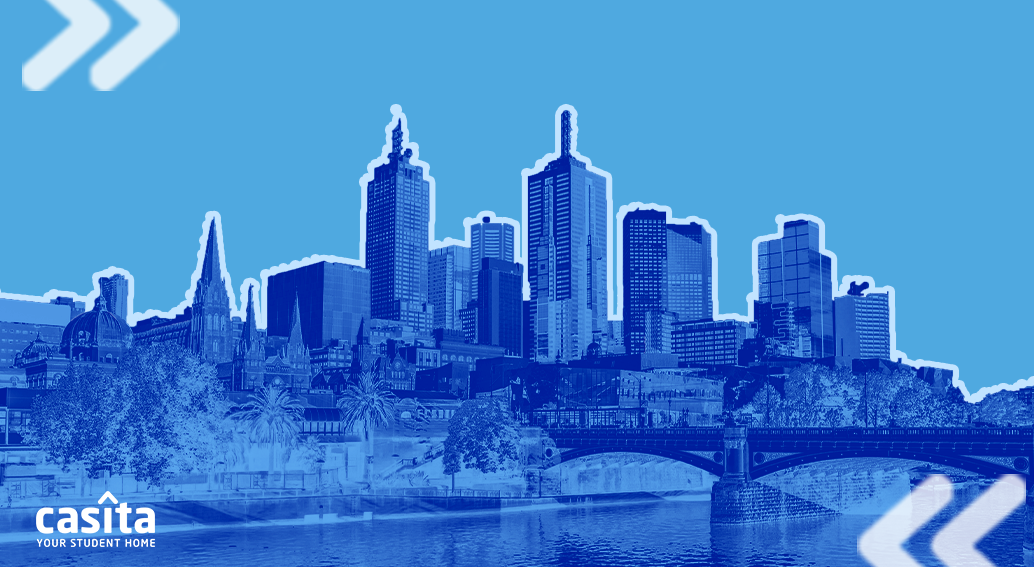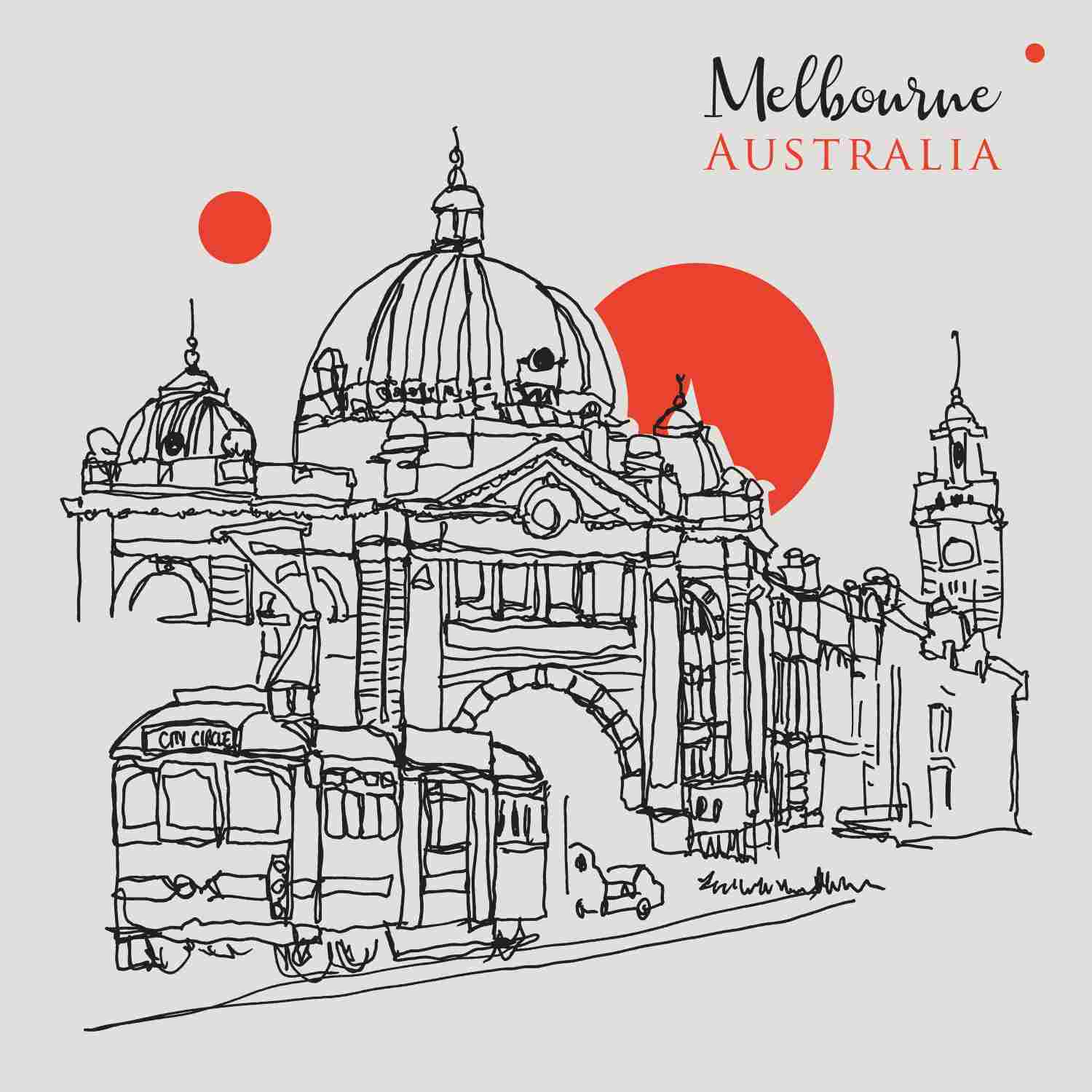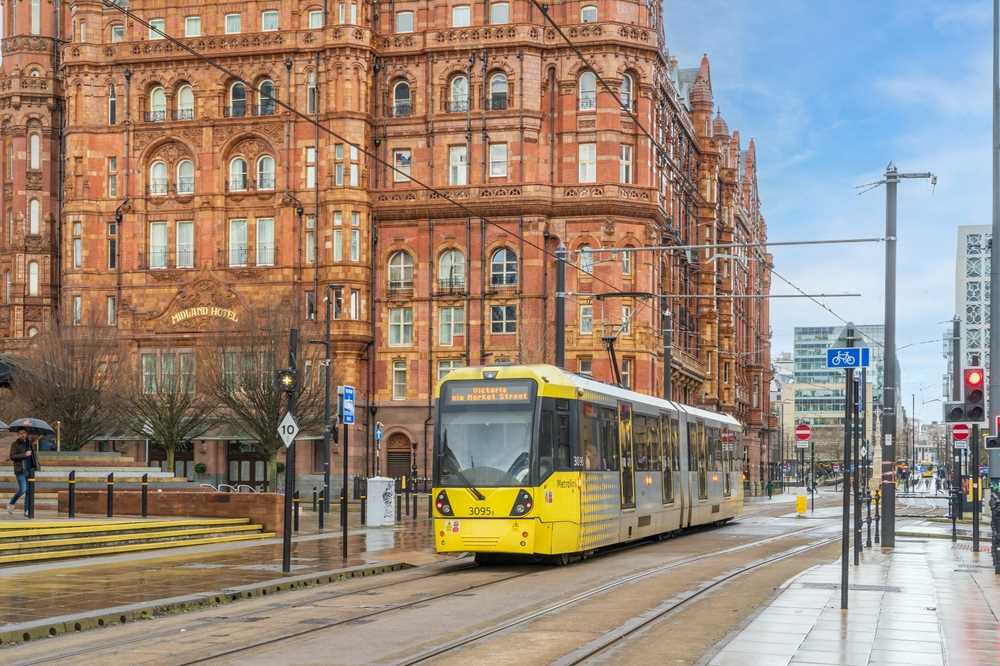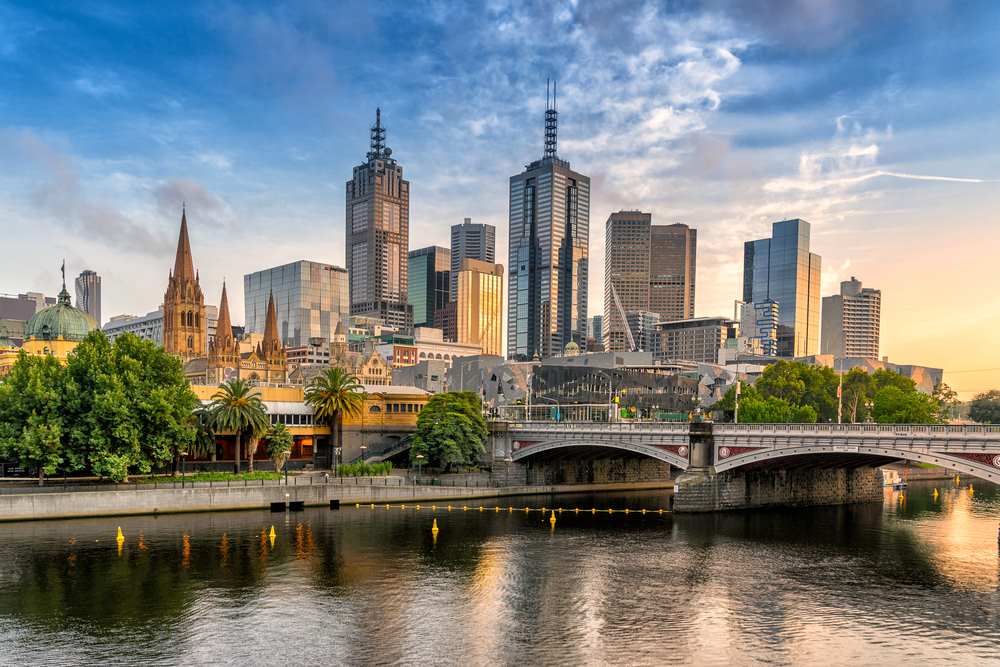A Student Guide to Melbourne
Exploring
10 mins read
Share

Updated at: 25 November, 2025
Published at: 27 September, 2022
By Amira Adel
A Student Guide to Melbourne
Exploring
10 mins read

Updated at: 25 November, 2025
Published at: 27 September, 2022
By Amira Adel
Share
Melbourne is Australia's second-largest city and is widely regarded as the country's cultural and sporting hub. The city is quite inviting and has a multicultural ambience that attracts most visitors. The city also has superb restaurants, gorgeous buildings, and historically significant landmarks.

1. How to Travel to Melbourne
Australia may be the world's smallest continent, yet it is a large region bordered on all sides by the sea. The majority of travellers arrive in Australia by plane, and even from nearby nations, flight times can be lengthy.
Flying to Melbourne
Melbourne Airport (also known as Tullamarine Airport) is the only international airport servicing Melbourne and Australia's second busiest airport, having opened in the 1970s.
The city is additionally served by Avalon Airport, Essendon Airport, and Moorabbin Airport, but mostly for domestic or cargo flights.
Finding your way to Melbourne, Australia's capital, is simple once you've arrived.
Travelling From the Airport to the City
1. By Bus
Melbourne Airport has a specialised shuttle service that runs between the terminal and the city. The major airport shuttle, the SkyBus, departs from two places outside the terminals and runs 24 hours a day, seven days a week. For the most part, SkyBus travels every 10 minutes between Southern Cross Station and the city.
Adult tickets are $19 one-way or $38 roundtrip, with up to four children travelling for free. Depending on traffic, the journey takes between 20 and 40 minutes.
Other shuttle buses that operate straight to some of the city's hotels are also available. Depending on the destination, prices range from $18 to $25, and there is no need to change buses at Southern Cross Station.
You can also take public transportation from the airport to the CBD (Central Business District). With a low-cost myki card, you can travel in comfort on both the train and the bus to your destination. You may take a train for the remaining 40-minute journey to Flinders Street in the CBD by taking the 901 bus to Broadmeadows station. During the week, services run every 15 minutes, and every half hour at night and on weekends. The price varies based on where you want to go.
2. By Train
There are no direct train connections between Melbourne Airport and the city centre at this time. If you prefer to go by rail, take the 901 bus to Broadmeadows Station and then transfer to the Craigieburn Line train to the city centre. This journey would take well over an hour to complete.
3. By Taxi
There are plenty of taxis waiting outside the Melbourne Airport exits in approved taxi ranks. The trip can take from 40 to 60 minutes (and sometimes longer during peak hours), and it will cost you roughly $60 for a single trip.
If it is more convenient, you can pre-book a taxi to pick you and your bags up from the airport. Rideways.com and taxicode.com, for example, allow you to book your pickup online.
In and around Melbourne, Uber drivers are also available, and you can book a ride using the app on your smartphone.
4. By Tram
Trams are a popular mode of public transit in Melbourne, with a network that stretches over 250 kilometres across the city. Although the City Trams are free, they do not run all the way to the airport. Before taking a tram ride or two, you'll need to get to Southern Cross station.

2. How to Get Around Melbourne
Once you've arrived in the city, you'll find a plethora of affordable, dependable, and conveniently accessible public transit alternatives.
Buses:
A myki card is required to travel on Melbourne's bus system. These cost $6 for adults and $3 for children, and you must have a positive balance to travel. Your myki card can be topped up at any of the city's over 800 retailers. Alternatively, a myki explorer pack, which includes a ready-to-use myki card, as well as useful information and special deals for visitors to the city, can be purchased. You can even donate your myki card to charity when you depart.
On most days, buses run from roughly 6:00 a.m. to 9:00 p.m., while on weekends, the Night Network provides all-night metropolitan trains, trams, and late-night buses.
You can find more information about bus routes and timetables at Public Transport Victoria..
By Tram:
Since 1885, trams have been a familiar sight in the city, with over 490 trams spanning 24 routes and 1,763 tram stops. It is the world's largest urban tramway network...and, even better, the City Tram Zone is completely free to use! As a result, it's a fantastic method to get around the centre of the city. Trams run from 8:45 a.m. to 4:00 p.m. on most days.
By Taxi:
Taxis and Ubers are readily available on Melbourne's streets, and you can hail one, pick one up at a certified taxi station, or pre-book a journey online. Melbourne cabs are commonly painted yellow, silver, or white and have a light on top of the cab roof. In the city, drivers must wear a uniform and keep an identity card on the dashboard at all times.
By Train:
The metro trains in Melbourne run between the suburbs and Flinders Street Station. The City Loop is Melbourne's own underground system, which, despite its tiny size, provides rapid and easy access to five stations in the CBD. Southern Cross Station is the main centre for both regional and interstate rail services in and out of Melbourne, so whether you want to travel farther into the suburbs or out into Victoria, this is the place to go. Your myki card will work on metro-area trains, but trains to the suburbs and beyond will require additional tickets.

3. Top Neighbourhoods in Melbourne
Melbourne is made up of several separate districts, each with its own personality and charm. Spend some time roaming between the many suburbs and gaining a real flavour for the Melbourne way of life to truly get to know Melbourne.
Melbourne CBD
Melbourne's Central Business District (or CBD) is the city's beating heart. The city has lots to see and do, from open spaces, royal gardens, and docklands cafes to high-end shopping at Bourke Street Mall and the Melbourne Centre. A day spent exploring the CBD is a day well spent, with first-class restaurants, hip cafes, boutiques, and historic arcades on every corner.
The Old Melbourne Gaol and the Melbourne Aquarium, which are snuggled among the new commercial buildings, provide a sense of gravity to the district. Meanwhile, Federation Square's museums and galleries add to the richness. On their lunch breaks, students, families, and travellers are frequently seen mixing with commuters - the CBD is open to all.
Where to Stay
St Kilda
St Kilda is a coastal district in Melbourne's inner suburbs that attracts travellers, families, and anyone looking to enjoy the great outdoors. St Kilda has a conventional seaside resort feel to it, from the grand homes of the past to the famous Sea Baths and wild rides at Luna Park.
Sip coffee on the seafront while watching the yachts go by, or visit one of the many excellent cake stores along Acland and Carlisle streets. When night strikes, the area's pubs and music venues become packed with late-night visitors and loud music.
Carlton
The Lygon Street Italian precinct in Carlton is recognised for its vast range of cafes and restaurants, earning it the nickname "Little Italy" from locals. The historic Melbourne General Cemetery and Princes Park, the home of Melbourne's Carlton Football Club, are also located there.
The contemporary Melbourne Museum and the domed 19th Century Royal Exhibition Building, which has World Heritage designation, are both located within the Carlton Gardens, which have plenty of lush avenues and open places to enjoy. Carlton is a lively and pleasant city with a global vibe.
Where to Stay:
Fitzroy
Fitzroy is the center of Melbourne's alternative culture. If you're looking for something cool and unusual, you'll find it there. Brunswick Street is home to secondhand booksellers, vintage apparel stores, offbeat boutiques, and independent retailers. Alternatively, you can grab a bite to eat at one of the area's many amazing vegan, vegetarian, and alternative cafés and eateries.
Fitzroy is known throughout Australia for its street art, music scene, and bohemian vibe, and it is also where Melbourne's Fringe Festival takes place. Just a short bus ride from the CBD, you can go and have cocktails with the chic creatives.
Download Our Extended Melbourne Guide
4. Top Libraries in Melbourne
State Library of Victoria
The State Library of Victoria is a cultural icon that includes a massive collection of books, as well as exhibits and galleries.
The library was founded in 1856 and has a majestic presence on Swanston Street, with equally grand interior areas. The La Trobe Reading Room is a six-story-high domed room with breathtaking views. The Cowen Gallery features beautiful artwork depicting Victoria's history for tourists to enjoy. Exhibitions and artworks are also held in the north and south rotundas, as well as the Keith Murdoch gallery.
The library has everything you need for a productive day at work, including free wifi, printing facilities, and a variety of seating options. Thousands of heritage objects, maps, manuscripts, and newspapers are housed at the State Library, in addition to books and artwork. Readers can also get their hands on digital content. And it's all for free!
Bargoonga Nganjin North Fitzroy Library
On a beautiful sunny day, who could refuse the opportunity to read out in the fresh air, surrounded by greenery? In 2017, Bargoonga Nganjin, which means “gather everyone” in Woiwurrung, the Wurunjuri language, was opened to the public.
The North Fitzroy location features a contemporary design and a variety of reading and study areas, including a first-of-its-kind rooftop garden. When you add in the library's broad youth and health programmes, as well as events like author talks, panel debates, music performances, Indigenous language exercises, and children's storytime sessions, Bargoonga Nganjin is guaranteed to achieve its original purpose.
5. Top Student Activities in Melbourne
Royal Botanic Gardens Victoria
The Gardens, which were founded in 1846 and span 89 acres, provide a piece of paradise within the city while also housing over 8,500 plant varieties and the wildlife that coexists with them. The Royal Botanic Gardens Victoria can't be matched for a relaxed day out and a true sense of Australia in the past.
Visit: Open daily from 7:30am to sunset. Entry is free.
Get There: Use tram stop 19, which is the Shrine of Remembrance/St Kilda Rd stop. Via bus, take Route 605 to Melbourne Observatory/Birdwood Avenue.
Eureka Skydeck 88
From the Eureka Skydeck 88, take the fastest elevator in the southern hemisphere to the 88th story for unrivalled views over Melbourne. If it doesn't catch your interest, consider The Edge, a glass-encased cube suspended 300 metres above the city. If you prefer not to take in the spectacular views while suspended in a giant clear box, there is a lovely coffee shop nearby.
Visit: Open daily from 10:00am. The Skydeck costs $20 and The Edge costs $12.
Get There: Flinders Street train station is just a 5-minute walk over the Yarra River
Federation Square
Federation Square is a huge mixed-use area in Melbourne's central business district. It's jam-packed with cafes, restaurants, and bars, as well as businesses selling everything from groceries to souvenirs to high-end clothing. The Square is a popular meeting spot in the city's heart, and it also hosts a variety of pop-up events and exhibitions. Federation Square features a year-round creative programme that showcases local talent.
Visit: Open 24 hours a day
Get There: Flinders Street train station is the nearest stop; it’s practically right on top of the square.
6. Top Cafes in Melbourne
Calere
Alicia Feng is the owner of Calere. Mo Zhou, her business partner, owns Gaea, a small fine-dining place next door. It's a little nook – seriously, it's tiny. You'll miss it if you blink.
Ona, one of Australia's greatest coffee roasters, provides this coffee. Both filter and espresso coffees use Ona's beans. There is also a limited selection of pastries to pick from.
St Ali
St Ali, the headquarters of an ambitious coffee enterprise with dreams for world dominance, is located in an out-of-the-way renovated warehouse in the back alleyways of South Melbourne (almost).
In 2005, Mark Dundon founded St Ali and began roasting coffee for the café and a few retail clients. He sold everything in 2008 and went on to open the fantastic Seven Seeds.
Salvatore Malatesta was the purchase, and St Ali has since become the flagship of his expanding cafe empire. Sensory Lab, Auction Rooms, and Clement are the other noteworthy cafes under the St Ali brand. In Jakarta, there is currently a St Ali as well.
Wide Open Road
Wide Open Road distinguishes apart in a city full of Scandi-cool eateries. It has an X element that can't be explained just by the building's industrial appeal, the always-bustling energy, or the personnel and customers' individual appearances.
Hootan Heydari (Heart Attack and Vine, Bedford Street) and Jono Hill (Heart Attack and Vine, Bedford Street) moved here in 2009 to start roasting their own coffee. Their initial cafe, A Minor Place (which has since been sold), was inadequate for the job.
They've steadily improved their roasting skills since then. Brazil, Colombia, Ethiopia, and Kenya are all represented in the Bathysphere blend. It's really good with milk. Excellent filter roasts are available in batch brew or pour-over formats. Larsen & Thompson leaves are soaked at specific temperatures and times using thermometers and timers, and tea is taken just as seriously. Then there's Chai La Lai, the in-house chai brand.
The cafe is light and airy, with plenty of communal hardwood benches and cosy booths. To complement the mint-green walls, terrazzo tiles, and a curved ply ceiling, the original masonry has been preserved. If you come in at the correct moment, you'll see the roaster in operation in the back windowed section.
Axil Coffee Roasters
As far as serious cafés go, this slick operation run by Dave Makin, a two-time Australian barista champion, and his partner Zoe (a coffee expert in her own right), is as remarkable as they come.
The Axil operation does not include the cafe. A huge stretch of a former bowling alley has been turned into an elevated community table, in addition to the CBD espresso shop and The Petty Officer. Diners can observe roasters at work in the cupping and training room next door in the glow of powder-coated milk urns-turned-light-fittings.
With a mix of black walls, highly polished concrete flooring, a corrugated iron ceiling, and a feature wall of white and green tiles, the team at Environmental Design STStyle has created a gloomy, masculine room. Succulents rise from the bench sitting all the way to the ceiling, thanks to a wall of metal framework lattice, which is commonly encountered on building sites reinforcing concrete slabs.
From buttermilk pancakes with chocolate, pear, praline, and zabaglione gelato to a smoked fish wrap with scrambled eggs, avocado & tomato salsa, and snow pea tendrils, there's something for everyone on the morning menu. The lunch menu is just as experimental, with four made-to-order sandwiches to choose from.
Seven Seeds
Melbourne has a plethora of excellent coffee shops. Even yet, there are a few spots that stand out from the crowd. Seven Seeds is without a doubt one of them.
Mark Dundon moved to Carlton after selling St ALi in 2008, where he and business partner Bridget Amor transformed a derelict warehouse into a roaster and cafe. The duo began pushing quality, provenance, and lighter roasts to suit filter, cold drip, and other brewing styles at a time when Melbourne was dominated by dark-roasted, untraceable, commodity-grade beans created only for espresso.
Stop by Carlton for an expertly crafted cup of the Golden Gate espresso mix, which has flavours of cocoa and toffee, or try a rotating single origin produced using your preferred method.
Now you have a plan for every single day you spend in Melbourne as a student. Tell us whenever you visit a place that we mentioned above. We would love to hear your experience.
Exploring
By Amira Adel
Share
Exploring
Updated at:
Published at:
By Amira Adel
Share


